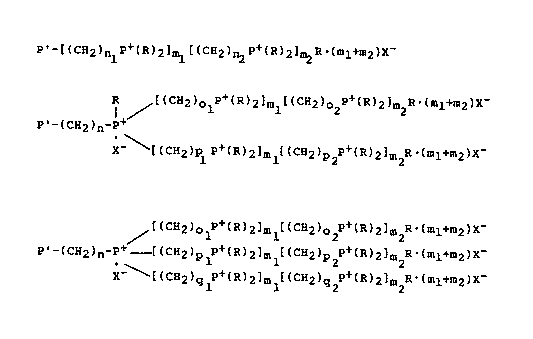Une partie des informations de ce site Web a été fournie par des sources externes. Le gouvernement du Canada n'assume aucune responsabilité concernant la précision, l'actualité ou la fiabilité des informations fournies par les sources externes. Les utilisateurs qui désirent employer cette information devraient consulter directement la source des informations. Le contenu fourni par les sources externes n'est pas assujetti aux exigences sur les langues officielles, la protection des renseignements personnels et l'accessibilité.
L'apparition de différences dans le texte et l'image des Revendications et de l'Abrégé dépend du moment auquel le document est publié. Les textes des Revendications et de l'Abrégé sont affichés :
| (12) Brevet: | (11) CA 2063499 |
|---|---|
| (54) Titre français: | SELS DE PHOSPHONIUM POLYMERIQUES INGERABLES PERMETTANT DE FAIRE BAISSER LE TAUX DE CHOLESTEROL SANGUIN |
| (54) Titre anglais: | INGESTIBLE POLYMERIC PHOSPHONIUM SALTS FOR THE LOWERING OF BLOOD CHOLESTEROL |
| Statut: | Périmé et au-delà du délai pour l’annulation |
| (51) Classification internationale des brevets (CIB): |
|
|---|---|
| (72) Inventeurs : |
|
| (73) Titulaires : |
|
| (71) Demandeurs : |
|
| (74) Agent: | SWABEY OGILVY RENAULT |
| (74) Co-agent: | |
| (45) Délivré: | 1996-06-18 |
| (22) Date de dépôt: | 1992-03-19 |
| (41) Mise à la disponibilité du public: | 1993-09-20 |
| Requête d'examen: | 1993-02-04 |
| Licence disponible: | S.O. |
| Cédé au domaine public: | S.O. |
| (25) Langue des documents déposés: | Anglais |
| Traité de coopération en matière de brevets (PCT): | Non |
|---|
| (30) Données de priorité de la demande: | S.O. |
|---|
The invention is concerned with novel ingestible
polymeric phosphonium salts having the formulas:
P'-t(CH2)n1P+(R)2]m1[(CH2)n2P+(R)2]m2R(m1+m2)X- (Ia)
<IMG> (Ib)
or
<IMG> (Ic)
wherein P' represents a cross-linked and non-digestible
polymer backbone; R is a lower alkyl radical; X- is a
pharmaceutically acceptable anion; m1 and m2 are,
independently, integers varying from 0 to 5 inclusive, with
the proviso thatin formula (Ia) ml + m2 1; n, n1 and n2
are, independently, integers varying from 0 to 6 inclusive,
with the proviso that when m1 1, n2 1; and o1, o2, P1
P2, q1 and q2 are, independently, integers varying from 1 to
6 inclusive. The polymeric phosphonium salts of the invention
are highly efficient sorbents for bile acids and salts and
can thus be used for reducing hypercholesterolemia in
affected humans.
Note : Les revendications sont présentées dans la langue officielle dans laquelle elles ont été soumises.
Note : Les descriptions sont présentées dans la langue officielle dans laquelle elles ont été soumises.

2024-08-01 : Dans le cadre de la transition vers les Brevets de nouvelle génération (BNG), la base de données sur les brevets canadiens (BDBC) contient désormais un Historique d'événement plus détaillé, qui reproduit le Journal des événements de notre nouvelle solution interne.
Veuillez noter que les événements débutant par « Inactive : » se réfèrent à des événements qui ne sont plus utilisés dans notre nouvelle solution interne.
Pour une meilleure compréhension de l'état de la demande ou brevet qui figure sur cette page, la rubrique Mise en garde , et les descriptions de Brevet , Historique d'événement , Taxes périodiques et Historique des paiements devraient être consultées.
| Description | Date |
|---|---|
| Le délai pour l'annulation est expiré | 2000-03-20 |
| Lettre envoyée | 1999-03-19 |
| Accordé par délivrance | 1996-06-18 |
| Demande publiée (accessible au public) | 1993-09-20 |
| Toutes les exigences pour l'examen - jugée conforme | 1993-02-04 |
| Exigences pour une requête d'examen - jugée conforme | 1993-02-04 |
Il n'y a pas d'historique d'abandonnement
Les titulaires actuels et antérieures au dossier sont affichés en ordre alphabétique.
| Titulaires actuels au dossier |
|---|
| LOWCHOL SCIENTIFIC INC. |
| Titulaires antérieures au dossier |
|---|
| GEORGE RONALD BROWN |
| LEON EDWARD ST. PIERRE |
| SOPHIE-DOROTHEE CLAS |
| ZHANJIE TAN |